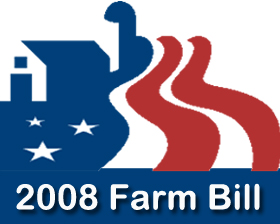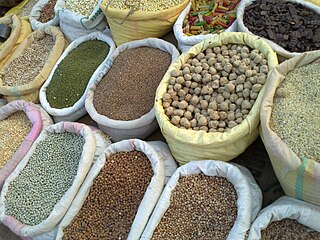Related Research Articles

The United States Department of Agriculture (USDA), also known as the Agriculture Department, is the U.S. federal executive department responsible for developing and executing federal laws related to farming, forestry, and food. It aims to meet the needs of farmers and ranchers, promote agricultural trade and production, work to assure food safety, protect natural resources, foster rural communities and end hunger in the United States and internationally.

Rapeseed, also known as rape, oilseed rape, and, in the case of one particular group of cultivars, canola, is a bright-yellow flowering member of the family Brassicaceae, cultivated mainly for its oil-rich seed. It is the third-largest source of vegetable oil and second-largest source of protein meal in the world.
The Commodity Credit Corporation (CCC) is a wholly owned United States government corporation that was created in 1933 to "stabilize, support, and protect farm income and prices". The CCC is authorized to buy, sell, lend, make payments, and engage in other activities for the purpose of increasing production, stabilizing prices, assuring adequate supplies, and facilitating the efficient marketing of agricultural commodities.
Mortgage Insurance is an insurance policy which compensates lenders or investors for losses due to the default of a mortgage loan. Mortgage insurance can be either public or private depending upon the insurer. The policy is also known as a mortgage indemnity guarantee (MIG), particularly in the UK.

The Federal Agriculture Improvement and Reform Act of 1996, known informally as the Freedom to Farm Act, the FAIR Act, or the 1996 U.S. Farm Bill, was the omnibus 1996 farm bill that, among other provisions, revises and simplifies direct payment programs for crops and eliminates milk price supports through direct government purchases.

A mortgage loan or, simply, mortgage is used either by purchasers of real property to raise funds to buy real estate, or alternatively by existing property owners to raise funds for any purpose, while putting a lien on the property being mortgaged. The loan is "secured" on the borrower's property through a process known as mortgage origination. This means that a legal mechanism is put into place which allows the lender to take possession and sell the secured property to pay off the loan in the event the borrower defaults on the loan or otherwise fails to abide by its terms. The word mortgage is derived from a Law French term used in Britain in the Middle Ages meaning "death pledge" and refers to the pledge ending (dying) when either the obligation is fulfilled or the property is taken through foreclosure. A mortgage can also be described as "a borrower giving consideration in the form of a collateral for a benefit (loan)".

In the United States, the farm bill is the primary agricultural and food policy tool of the federal government. The comprehensive omnibus bill is renewed every 5 years or so and deals with both agriculture and all other affairs under the purview of the United States Department of Agriculture.

The Food, Conservation, and Energy Act of 2008 was a $288 billion, five-year agricultural policy bill that was passed into law by the United States Congress on June 18, 2008. The bill was a continuation of the 2002 Farm Bill. It continues the United States' long history of agricultural subsidies as well as pursuing areas such as energy, conservation, nutrition, and rural development. Some specific initiatives in the bill include increases in Food Stamp benefits, increased support for the production of cellulosic ethanol, and money for the research of pests, diseases and other agricultural problems.

The Federal Crop Insurance Corporation (FCIC) is a wholly owned government corporation managed by the Risk Management Agency of the United States Department of Agriculture. FCIC manages the federal crop insurance program, which provides U.S. farmers and agricultural entities with crop insurance protection.
In United States federal agricultural policy, the term commodity programs is usually meant to include the commodity price and income support programs administered by the Farm Service Agency and financed by the Commodity Credit Corporation (CCC). The commodities now receiving support are:
- those receiving Direct and Counter-cyclical Program (DCP) payments, specifically wheat, corn, grain sorghum, barley, oats, upland cotton, rice, soybeans and other oilseeds, and peanuts;
- those eligible for nonrecourse marketing assistance loans, which includes the previous mentioned commodities plus wool, mohair, honey, dry peas, lentils, and small chickpeas; and
- those having other unique support, including sugar, and milk.

The Food, Agriculture, Conservation, and Trade (FACT) Act of 1990 — P.L. 101-624 was a 5-year omnibus farm bill that passed Congress and was signed into law.
The Direct and Counter-cyclical Payment Program (DCP) of the USDA provides payments to eligible producers on farms enrolled for the 2002 through 2007 crop years. There are two types of DCP payments – direct payments and counter-cyclical payments. Both are computed using the base acres and payment yields established for the farm.
In United States agricultural policy, the payment limitation refers to the maximum annual amount of farm program benefits a person can receive by law.
The 2002 farm bill replaced the longtime (65-year) support program for peanuts with a framework identical in structure to the program for the so-called covered commodities. The three components of the Peanut Price Support Program are fixed direct payments, counter-cyclical payments, and marketing assistance loans or loan deficiency payments (LDPs). The peanut poundage quota and the two-tiered pricing features of the old program were repealed. Only historic peanut producers are eligible for the Direct and Counter-cyclical Program (DCP). All current production is eligible for marketing assistance loans and LDPs. Previous owners of peanut quota were compensated through a buy-out program at a rate of 55¢/lb. ($1,100/ton) over a 5-year period.
In United States agricultural policy, a marketing loan repayment provision is a loan settlement provision, first authorized by the Food Security Act of 1985, that allowed producers to repay nonrecourse loans at less than the announced loan rates whenever the world price or loan repayment rate for the commodity were less than the loan rate. Marketing loan provisions became mandatory for soybeans and other oilseeds, upland cotton, and rice and were permitted for wheat, corn, grain sorghum, barley, oats, and honey under amendments made by the 1990 farm bill. The 1996 farm bill retained the marketing loan provisions for wheat, feed grains, rice, upland cotton, and oilseeds. The 2002 farm bill continued marketing assistance loans and expanded their application to wool, mohair, dry peas, lentils, and small chickpeas.
Under the 2002 farm bill, the following commodities are eligible for marketing assistance loans and are called loan commodities: wheat, corn, grain sorghum, barley oats, upland cotton, extra long staple (ELS) cotton, rice, soybeans, other oilseeds, wool, mohair, honey, dry peas, lentils, and small chickpeas. With the exception of extra long staple cotton, farmers agreeing to forgo the loans are eligible for loan deficiency payments (LDPs) on actual production of loan commodities.

A grain is a small, hard, dry seed, with or without an attached hull or fruit layer, harvested for human or animal consumption. A grain crop is a grain-producing plant. The two main types of commercial grain crops are cereals and legumes.
References


The Congressional Research Service (CRS), known as Congress's think tank, is a public policy research arm of the United States Congress. As a legislative branch agency within the Library of Congress, CRS works primarily and directly for Members of Congress, their Committees and staff on a confidential, nonpartisan basis.